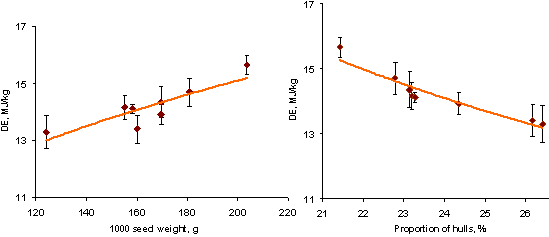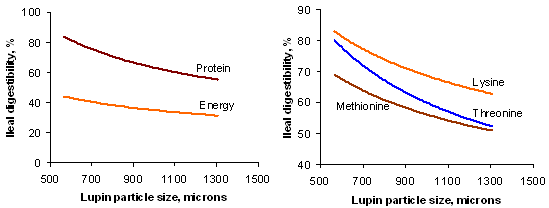Variation in digestible energy content of lupins and its predictability
Variation in digestible energy (DE) content of 8 aggregate lupin samples (4 varieties x 2 growing locations) was determined using 50-kg male pigs. The DE content of lupins was ranged from 13.3 to 15.7 MJ/kg, with a mean value of 14.2 MJ/kg. Subsequent research at DAFWA showed that this variable DE content of lupins can be predicted by measuring proportion of hulls (DE = -0.4107 x % hull + 23.998) or weight of thousand seeds (DE = 0.0292 x thousand seed weight + 9.3838), with 88% and 78% accuracy, respectively (Figure 2). Alternatively mean of 2-3 repeats of 100 grain weights can be used for prediction of DE with slightly reduced accuracy (DE = 0.2897 x 100 seed weight + 9.4508, R2=0.76). Use of these prediction equations for diet formulation would improve precision of dietary energy levels that pigs required at particular physiological status.

Ileal and total tract energy and protein digestibility
As proteins digested in the large intestine are generally not used in body protein synthesis, ileal protein digestibility along with energy digestibility was measured with 50-kg entire male pigs. An average 79 per cent of protein was digestible and available for body protein accumulation (Table 1). Interesting finding was that most of protein was digested and available for pigs at ileal levels while significant amount of digestible energy was derived from the hindgut fermentation because of high fibre content of lupins.
Table 1. Ileal and total tract digestibility of energy and protein
| Ileal | Total tract | |
| Energy digestibility | 43 | 76 |
| Protein digestibility | 79 | 81 |
Apparent and standardised ileal amino acid digestibility
Apparent ileal amino acid digestibility of cv. Mandelup was determined using 45-kg male pigs and calculated the standardised ileal amino acid digestibility using literature value of endogenous amino acid flow. Average apparent and standardised ileal digestibilities of amino acid were 84% and 88%, respectively, which is comparable to soybean meal (Table 2).
Table 2. Amino acid composition of Mandelup and apparent and standardised ileal digestibility of amino acids determined with 50-kg male pigs.
| Chemical content | Ileal digestibility | ||
| Lupin (Mandelup) | AID1 | SID2 | |
| DM, g/kg |
895 | ||
| CP, g/kg |
288 | ||
| Amino Acids, g/kg | |||
| Essential AA | |||
| Arg |
29.1 | 94 | 95 |
| His |
8.2 | 80 | 82 |
| Ile |
13.3 | 77 | 80 |
| Leu |
20.8 | 77 | 80 |
| Lys |
15.2 | 81 | 84 |
| Met |
1.7 | 64 | 71 |
| Phe |
11.9 | 73 | 76 |
| Thr |
10.3 | 77 | 82 |
| Val |
13.3 | 73 | 76 |
| Non-essential AA | |||
| Ala |
10.7 | 70 | 76 |
| Asp |
28.8 | 82 | 85 |
| Glu |
60.9 | 76 | 78 |
| Gly |
13.1 | 69 | 75 |
| Pro |
12.1 | 81 | 97 |
| Ser |
12.3 | 74 | 77 |
| Tyr |
7.1 | 73 | 77 |
| Total AA3 |
269 | 84 | 88 |
2SID: Standardised ileal digestibility, %.
3Sum of AA excluding cystine and tryptophan.
Processing of lupins
Hulls and kernels of Australian sweet lupins are durable and hard to break, which means without reasonable mechanical grinding nutrients in lupins would not be digested and absorbed efficiently. To test this hypothesis, an experiment was conducted investigating the impact of grinding of lupins on the energy and amino acid (AA) availability when fed to grower/finisher pigs. Lupins (cv. Mandelup) were ground to have mean particle sizes varying between 567 μm and 1,304 μm, which are typical of the range found in commercial production, and fed to pigs. The results showed that decreasing particle size of lupins from coarse to fine (1,304 μm to 567 μm) significantly increased ileal digestible nitrogen (N), energy and amino acids (Figure 3). Put another way, every 100 μm increase in lupin particle size over 567 μm reduced ileal digestible N, energy, lysine, methionine, threonine, leucine, isoleucine, valine in lupin seeds by 6%, 7%, 4%, 4%, 6%, 5%, 5% and 6% units, respectively.
Figure 3. Effect of lupin particle size on apparent ileal digestibility of energy, nitrogen and amino acids

Conclusion
Australian sweet lupins (narrow-leafed lupins) and yellow lupins are excellent alternatives for soybean meals in diets for grow/finish pigs. It is apparent that even relatively young pigs (around 30 kg) could handle the higher concentration of NSP from lupins as efficiently as the NSP from SBM. It is critical to balance dietary amino acid compositions through supplementation of synthetic amino acids, when increasing the lupin concentration in the diet for pigs. Ileal amino acid digestibility of lupins was comparable to that of soybean meal, however, finer grinding of lupins is critical for efficient utilisation of amino acids.



